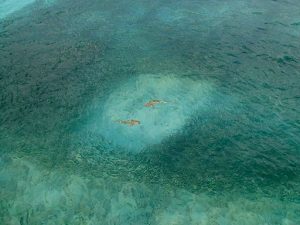A Century of Fish Biomass Decline in the Ocean
By Lindsay Jennings, RJD Intern
There have been many interpretations and heated debates in the scientific community surrounding the trend of global fish populations. Although some advocate increasing trends, others are quick to counter with their evidence of declining trends. And while previous local and regional studies have reported heavy declines of large oceanic predators (e.g. finish and sharks), subsequent studies have reported an increase and abundance of forage fish (e.g. anchovies and sardines). This increase in biomass is thought to be a result of decreasing predator abundance coupled with the consequences of human exploitation. Because ‘fishing down the food web’ is not a universally accepted phenomenon, and to get to the bottom of the debate, Villy Christensen et al. (2014) aimed to specifically evaluate how the biomass of high tropic level species has changed relative to the biomass of lower trophic level species.
The researchers built a database with 200 data-rich ecosystem models – currently the most widely used ecosystem modeling approach in the marine environment. These models delivered ‘snapshots’ of how much life was in the ocean at a given point in time and space, between the years 1880 and 2007. From those models, Christensen et al. distributed previously-published and well-documented fish biomass based on habitat preference, ecology, and feeding conditions. With those global distributions, over 68,000 estimates of biomass were obtained for predatory or ‘table’ fish (trophic levels 3.5 and above) and forage fish (trophic levels 2.0 – 3.0). Finally, the spatial models and thousands of predictions of fish biomass were used as the basis for multiple regression analyses to predict actual trends in fish populations.

Global distribution of the ecosystem models used in this study. Color density is indicative of the number of models at each location. Photo courtesy Christensen et al. (2014)
Drawing a global picture of how the abundance of fish has changed in the world’s oceans over the last 100 years, results predicted that the biomass of predatory fish in the world’s oceans has declined by two-thirds over the last 100 years. Most alarming though is that 55% of that decline has occurred in the last 40 years. This decline in predatory fish was found to be closely linked to an increase in global fishing effort, indicating that we may have been fishing past the maximum sustainable yield (MSY) for quite some time. Consequently, forage fish biomass has increased over the last 100 years, thought to be result of predation release.

Global spatial distribution of predatory fish for (a) 1950 and (b) 2010. Photo courtesy Christensen et al. (2014)
While the researchers are confident there will be fish in our oceans in the future, they are quick to point out that those fish assemblages will be very different from the ones we have currently – with small prey fish beginning to dominate marine ecosystems. With advancing technology and increased fishing effort, this study has important implications for the management of our ocean’s marine resources. There must be a wide recognition of the growing importance of forage fish in the marine ecosystem, followed by appropriate measures to make sure these fish stocks, too, do not start to decline.
Citation: Christensen, V., Coll, M., Piroddi, C., Steenbeek, J., Buszowski, J., & Pauly, D. (2014). A century of fish biomass decline in the ocean. Marine Ecology Progress Series, 512, 155-166.



So am wondering, what was the trend for total ocean biomass overall? Did the increase in prey fish outweigh the decrease in predatory fish? And what is the trend when all oceanic species (fish and non-fish) are grouped together?
The ocean conditions are becoming similar to those in the late Cambrian era where CO2, H2S and methane levels were high relative to dissolved 02. Human impacts, be it over fishing or pollution have turned the evolutionary clock back to the age of jellyfish 505 million years ago.